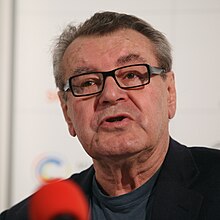Cinema of the Czech Republic
The earliest Czech cinema began in 1898 with Jan Kříženecký, later major contributions were made by interwar directors such as Karel Lamač and Martin Frič, with Barrandov Studios founded in 1933.Many prominent people of Czech cinema left the country before World War II including directors Karel Lamač and Gustav Machatý, cinematographer Otto Heller, actors Hugo Haas and Jiří Voskovec and producer Josef Auerbach.Studio owner Miloš Havel and actresses Lída Baarová and Adina Mandlová went into exile in Germany or Austria after they were accused of collaborating with Nazis during the war.Examples range from highly stylised, even avant-garde, literary adaptions using historical themes (e.g. Jan Němec's Diamonds of the Night (Démanty noci)) to semi-improvised comedies with contemporary subjects and amateur actors (e.g., Miloš Forman's The Firemen's Ball (Hoří, má panenko)).However, a frequent feature of films from this period was absurd, black humour and an interest in the concerns of ordinary people, particularly when faced with larger historical or political changes.Three Wishes for Cinderella, a fairy-tale film from 1973, became a holiday classic in Czechoslovakia and several European countries, including Germany, Switzerland, Spain, Sweden and Norway.
PraguescreensBontonfilmCulture of the Czech RepublicArchitectureCuisineFolkloreLiteraturePhilosophySportsTheatreCzech RepublicAustrian-Hungarian EmpireJan KříženeckýKarel LamačMartin FričOtakar VávraNazi occupationThe Proud PrincessThe Fabulous World of Jules VerneMiloš FormanJiří MenzelMarketa LazarováViktor PonrepoJan Evangelista PurkyněKarl AntonSvatopluk InnemannPřemysl PražskýGustav MachatýKdyž struny lkajíTonka of the GallowsBarrandov StudiosMiloš HavelMiroslav CikánJan SvitákFrantišek ČápVladimír ČechVáclav KrškaKarel SteklýRudolf HrušínskýOtto HellerHugo HaasJiří VoskovecVladislav VančuraKarel HašlerAnna LetenskáKarel PoláčekLída BaarováAdina MandlováCzech Film ArchiveKarlovy Vary International Film FestivalJourney to the Beginning of TimeThe Good Soldier ŠvejkThe Emperor and the GolemThe Princess with the Golden StarCzechoslovakian New WaveCzechoslovak New WaveVěra ChytilováKarel KachyňaVojtěch JasnýJan NěmecDiamonds of the NightThe Firemen's Ballacid westernLemonade JoeItalian neorealismFrench New WaveStalinismnormalizationThree Wishes for CinderellaVelvet RevolutionDivided We FallCosy DensWalking Too FastList of Czechoslovak filmsList of Czech filmsList of Czech animated filmsList of Czech films considered the bestList of most expensive Czech filmsList of highest-grossing Czech filmsJiří Bartastop-motion animationHynek BočanFrank DanielSaša GedeonLadislav HelgeJuraj HerzJan HřebejkJaromil JirešPavel JuráčekJan S. KolárJiří KrejčíkOldřich LipskýIvan PasserBřetislav PojarJindřich PolákAlfred RadokKarel ReiszJosef RovenskýEvald SchormBohdan SlámaJan ŠvankmajerJan SvěrákJiří TrnkaHermína TýrlováFrantišek VláčilVáclav VorlíčekJiří WeissPetr ZelenkaKarel ZemanThe Shop on Main StreetJán KadárElmar KlosLoves of a BlondeClosely Watched TrainsMy Sweet Little VillageThe Elementary SchoolŽelaryOndřej TrojanMen Without WingsVánoční senSpringman and the SSThe TrapDog's HeadsThe Good Soldier SchweikDalibor
